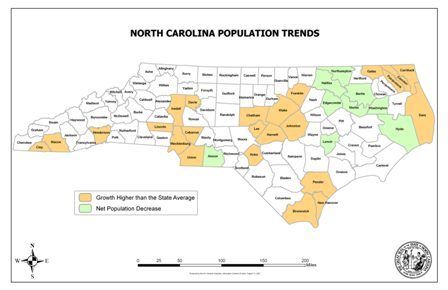The North Carolina State Data Center has lots of numbers. Of interest to the legislative community is their population projections. Most recently updated June 20, 2007, the Population Growth 2000-2010 dataset gives some ideas about the next round of redistricting scheduled for the 2011 session. Based on the analysis below, Wake and Mecklenburg Counties are each likely to gain two House seats, and Wake a Senate seat. Remember of course, all 2010 numbers are just projections.
Growth in an urbanizing pattern
The 2010 estimates show a total estimated population growth for the decade of 17.4%. Since the number of House and Senate seats is fixed at 120 and 50 respectively, counties that grow faster than the state average gain representation, while those with less lose representation. Just 24 of the 100 counties are projected to grow at a rate higher than the State average. Counties growing at a higher average are mostly around the Triangle, Charlotte area, and the coast.
The 24 counties that are estimated to grow at a higher rate than the State average are:
Brunswick (51%), Cabarrus (35%), Camden (52%), Chatham (27%), Clay (25%), Currituck (45%), Dare (22%), Davie (27%), Franklin (27%), Gates (19%), Harnett (23%), Henderson (21%), Hoke (43%), Iredell (32%), Johnston (40%), Lee (20%), Lincoln (21%), Macon (19%), Mecklenburg (33%), New Hanover (25%), Pasquotank (24%), Pender (34%), Union (65%), and Wake (43%).
Net increase in House seats
The five counties with the biggest projected net increase in House seats are: Wake 2.07, Mecklenburg 1.38, Union 0.74, Johnston 0.34, and Brunswick 0.31. Senate gains would be in the same proportion. Remember of course, all 2010 numbers are just projections.
The Stephenson cases
The North Carolina Supreme Court in its 2002 Stephenson I opinion and 2003 Stephenson II opinion said that all districts must be within plus or minus 5% of population equality, and absent Voting Rights Act consideration, any county entitled to a whole number of seats (within the 5% tolerance) will have all those districts as subsets within that county. This is often referred to as a “single-county cluster”, and simplifies the beginning part of redistricting.
Single county clusters in 2000 and 2010
In 2000 there were three single-county clusters in the Senate: Wake 4, Forsyth 2, and New Hanover 1. In 2000 there were ten single-county clusters in the House: Alamance 2, Buncombe 3, Cabarrus 2, Guilford 6, Lincoln 1, Mecklenburg 10, Randolph 2, Rowan 2, Wake 9, Wilkes 1. Pitt would have been a 2 seat single-county cluster except for division on account of the Voting Rights Act.
For 2010, projections show two single-county Senate clusters, Mecklenburg and Wake each with 5 seats. In the House projected single-county clusters are: Buncombe 3, Caldwell 1, Catawba 2, Davidson 2, Guilford 6, Iredell 2, Lincoln 1, Mecklenburg 12, and Wake 11. Pitt would still be a 2-seat single county cluster were it not for the Voting Rights Act. Wilson would be a 1-seat single county cluster Remember of course, all 2010 numbers are just projections.
Urbanization
A look at clusters of counties around the Triangle, Triad, and Charlotte area show the following changes in House seats for a region. (Senate changes would be proportional)
Triad: Alamance, Davidson, Forsyth, Guilford, Randolph, and Rockingham. Drops from 18.31 to 17.40 seats. (-0.91)
Triangle: Chatham, Durham, Franklin, Orange, Johnston, and Wake. Increases from 17.67 to 20.12 seats. (+2.45)
Charlotte area: Cabarrus, Gaston, Iredell, Lincoln, Mecklenburg, and Union. Increases from 19.79 to 22.21 seats. (+2.42)
Spreadsheet
I’ve taken the State Data Center data, added columns for changes in House and Senate seats and uploaded it as my own document and also as an html table to show all the numbers used above.
Population Trends Map
I’ve ppsted an image of a population trend map- below, a 536k .pdf file of the map is here. Population changes are shown in two colors, the counties that have grown faster than the State average (shown in orange) and counties that are projected to have a decline in population (shown in green – the lighter color on a black and white printer)
(thanks to Raleigh Myers and Dan Frey for assistance with the map, Kelly Stallings on the html table)

Gerry,
So if these projections hold true Johnston County would gain an additional seat in the state House and possibly a seat in the state Senate. Thanks I really like your blog!
Michael